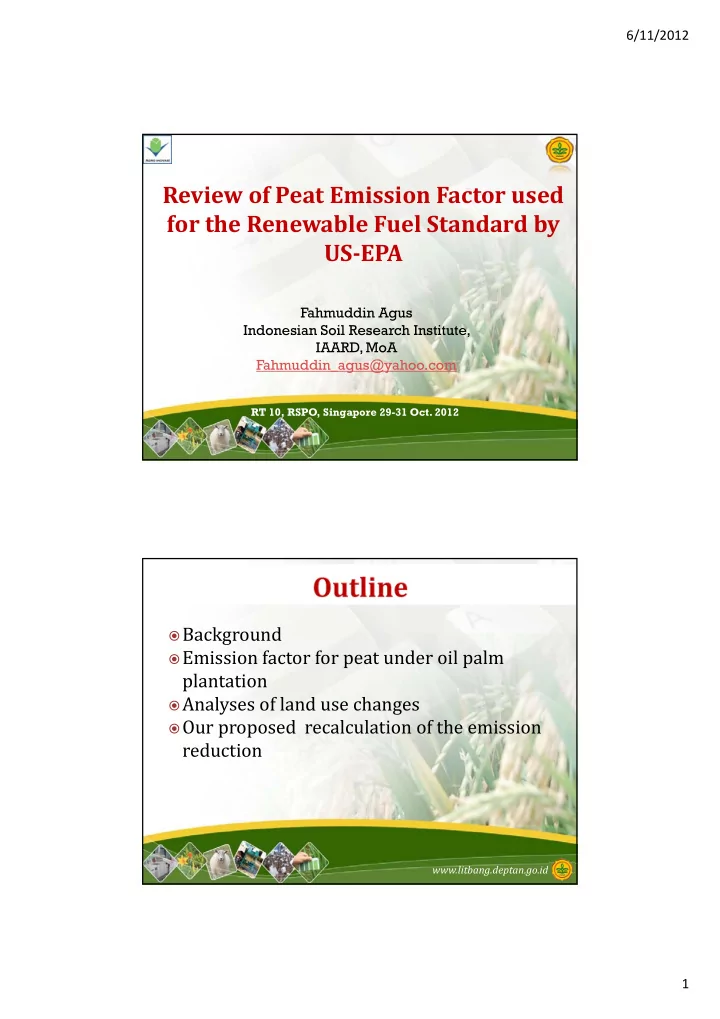

6/11/2012 Review of Peat Emission Factor used for the Renewable Fuel Standard by US ‐ EPA Fahmuddin Agus Indonesian Soil Research Institute, IAARD, MoA Fahmuddin_agus@yahoo.com RT 10, RSPO, Singapore 29-31 Oct. 2012 Background Emission factor for peat under oil palm plantation Analyses of land use changes Our proposed recalculation of the emission reduction www.litbang.deptan.go.id 1
6/11/2012 US‐EPA was studying the possibility of using palm oil as a feedstock to produce biodiesel and renewable diesel starting in 2022 under the Renewable Fuel Standard (RFS) program using lifecycle greenhouse gas (GHG) emission analysis. www.litbang.deptan.go.id Federal Register / Vol. 77, No. 18 / Friday, January 27, 2012 / Notices ENVIRONMENTAL PROTECTION AGENCY [EPA–HQ–OAR–2011–0542; FRL–9608–8] Notice of Data Availability Concerning Renewable Fuels Produced From Palm Oil Under the RFS Program AGENCY: Environmental Protection Agency (EPA). ACTION: Notice of data availability (NODA ). www.litbang.deptan.go.id 2
6/11/2012 EPA analysis: biodiesel and renewable diesel from palm oil do not meet the minimum 20% lifecycle GHG emission reduction threshold. Why? www.litbang.deptan.go.id EPA chosen value is 95 Mg CO2 ha ‐1 yr ‐1 Our chosen value is 38 Mg CO2 ha ‐1 yr ‐1 Why?? www.litbang.deptan.go.id 3
6/11/2012 4
6/11/2012 Change in C stock ‐ change in peat bulk density (BD), ‐ change in peat C content, and ‐ peat volume (thickness and area) Or CO2 (GHG) flux www.litbang.deptan.go.id Peat subsidence at 215 sites (points); 125 in Acacia plantation, 39 in oil palm plantation and 51 in peat swamp forest From the 39 monitoring points on OP plantations, peat BD was monitored at 10 points (pits) Duration of peat subsidence measurement on OP plantation was one year (July 2009 to June 2010), twice per month Long term peat subsidence trend were based on observations from locations 2, 5–7 and 18 years after drainage commencement, under different land uses www.litbang.deptan.go.id 5
6/11/2012 • No data for initial BD, it was assumed the same as the current BD below the average water table. • No observastion of organic matter content, it was assumed 55% throughout the profile, across land uses www.litbang.deptan.go.id www.litbang.deptan.go.id 6
6/11/2012 Other issues about subsidence technique From 23 Mg CO2 ha -1 yr -1 , reinterpreted to ???? Wide estimate of emission/subsidence ratio high uncertainty www.litbang.deptan.go.id 7
6/11/2012 Page et al. (2011): Hooijer et al. (2012) result is comparable to Jauhiainen et al. (2012) on Acacia Plantation. Yes, but: Different crop Different location www.litbang.deptan.go.id 20‐56.5 (average of 38 Mg CO 2 ha ‐1 yr) (Fargione et al. 2008; Reijnders & Huijbregts 2008; Wicke et al. 2008; Murdiyarso et al. 2010; Murayama & Bakar 1996 ; Jauhiainen et al. 2001; Melling et al. 2005; Melling et al. 2007; Agus et al. 2010. High geographic representation, although mostly from short term measurement 8
6/11/2012 Our recent findings: Jambi (15 yr old OP) Peat decomposition Root-related (Heterotrophic respiration): respiration 33 Mg ha -1 year -1 74% 68% 58% 41% Average total respiration = 63 Mg ha -1 year -1 Least root-affected respiration (peat decomposition): 33 t CO2/ha. This is the value that should be accounted in GHG issues. 50% Root respiration Het resp:38 Mg ha -1 yr -1 42% 32% 16% Average total respiration = 51 Mg ha -1 yr -1 ; Peat decomposition: 38 t CO2/ha 9
6/11/2012 Hooijier . Closed chamber et al.. 2012 20-46 Mg ha -1 year -1 J+R_S 85 J+R_S 60 Land cover types EPA Projection Agus et al. (2011) for 2022 (Table Historical 1990- Historical 2000- II.5., NODA), 2010 2010, for based on 2000- Sumatra and 2009 trend Kalimantan only (a recalculation) Forest 43% 34% (6% Pr 28% Forest) Mixed 38% 34% 1) 26% Shrubland 0% 26% 23% Savanna 10% Grassland and 8% 6% 23% Croplands Wetland 1% www.litbang.deptan.go.id 10
6/11/2012 50 Mineral soil 45 40 Peatland Area (million ha) 35 30 40.8 25 20 28.9 27.1 15 18.7 10 5 7.6 3.7 3.9 4.2 0 0.1 0.5 Undist Dist forest Agric Shrub Grassland forest High potential for future OP expansion Island Peatland area (ha) Wahyunto et al. Revised Difference (2003, 2004, 2006) Wahyunto et al. (2003, 2004, 2006) by Ritung et al. (2011) Sumatra 7,212,798 6,436,649 776,149 Kalimantan 5,830,228 4,778,004 1,052,224 Papua 7,759,372 3,690,921 4,868,451 Total 20,802,398 14,905,594 5,896,804 www.litbang.deptan.go.id 11
6/11/2012 Pledge of the Indonesian government to reduce emission 26% by 2020. Presidential Instruction No. 10, 2011 on the moratorium of new permit for using primary forest and peatland Presidential Instruction, No. 26, 2011 on NAMA’s, encouraging the use of shrub and low carbon stock idle lands for future development www.litbang.deptan.go.id 2005 Diesel PO Renewable Emissions Category Baseline PO Biodiesel Diesel Net Agriculture (w/o land use change) - 5 5 Land Use Change - 46 47 S1: Peat EF of 38 Mg CO2/ha/yr 32 33 S2: S1 + Ind forest area affected adjusted from 43 to 28% and shrubland from 0 to 15% for Indonesia 30 30 S3: S2 + Use new peatland map of Ind (14% less peatland in Sumatra and Kalimantan) 29 30 Fuel production 18 25 31 Fuel and feedstock transport - 4 4 Tailpipe Emissions 79 1 Net Emissions 97 81 87 % Reduction Relative to Baseline (EPA) EPA estimate -17% -11% S1 -31% -25% S2 -33% -27% S3 -34% -28% 12
6/11/2012 EF for peat decomposition of 95 Mg CO 2 ha ‐1 yr ‐1 , based on subsidence measurement was not supported by valid C stock change observation. Our estimate as high as 38 Mg CO 2 ha ‐1 yr ‐1 represents direct measurements of CO 2 fluxes using closed chambers from several locations in SE Asia and thus more geographically representative. Shrubland change to OP plantation is an importat trajectory, esp. For Indonesia and this has not been considered by EPA. EPA should also consider the land use change policies of Indonesia and Malaysia www.litbang.deptan.go.id 13
Recommend
More recommend